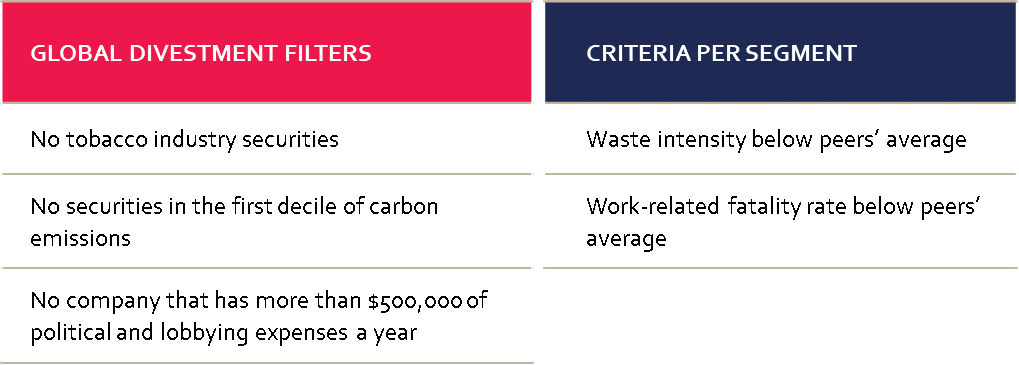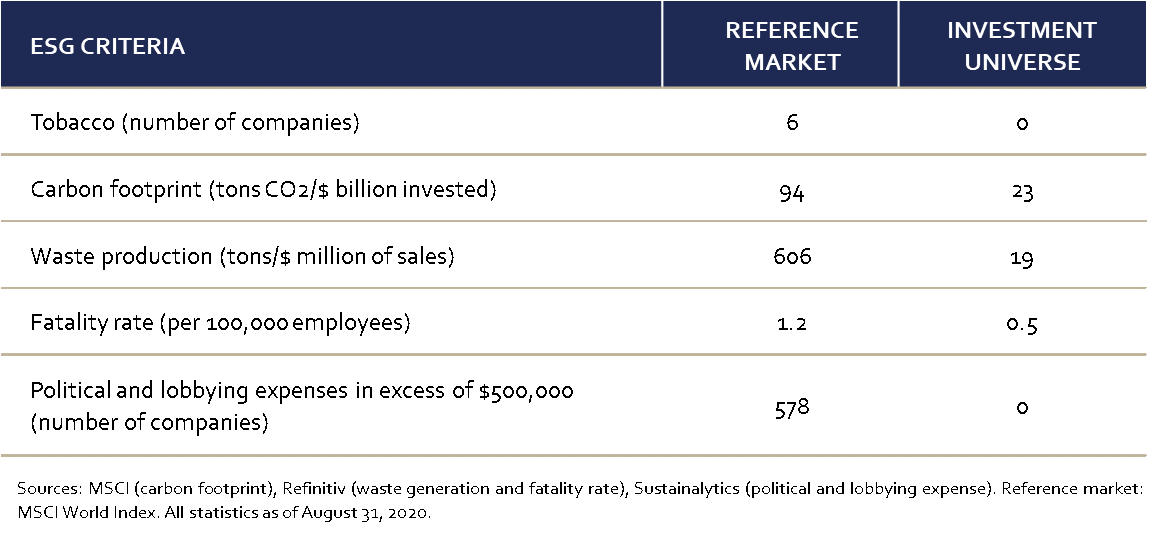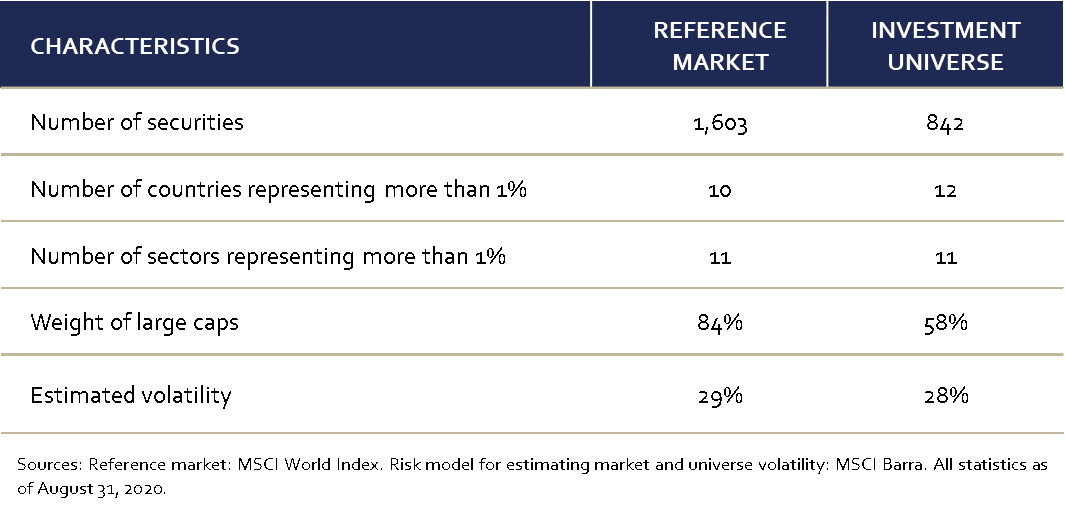How top-down portfolio managers can step up their ESG integration
November 26, 2020
Top-down management of an equity portfolio involves analyzing major market segments, such as regions, countries and sectors. Security selection plays a decidedly secondary role. Yet, responsible equity investment is based mainly on information specific to individual securities, namely the increasingly mainstream ESG criteria. That being said, there is nothing to prevent managers who use a top-down approach from implementing credible responsible investment. We propose to do so by building investment universes that are consistent with managers’ decision-making levers and ESG-related objectives.
An investment universe adapted to the top-down style
For a top-down strategy to be implemented in an investment universe, this universe must be representative of the reference market. Take the example of managers who want to invest in European banks. Their primary objective is to invest in a representative subset of the European banking industry. Exposure to the subset is more important than selection of individual securities. This principle is generally applicable to all the decision-making levers specific to top-down management. Thus, all the major segments of the reference market (geographical and sectoral) should be well represented in the investment universe.
ESG criteria and the importance of setting objectives
The ESG criteria are numerous and varied: they include carbon footprint, water intensity, board independence, workplace mortality rate and so on. To guide the construction of a responsible investment universe, it is important to set precise and measurable objectives.
The objectives are used to evaluate the selected methodology. Does it truly enable the managers to meet their responsible investment targets? Representativeness of the reference market, referred to above, is a requirement that often leads to application of ESG criteria by market segment, occasionally with undesirable or unexpected effects.
Carbon footprint is a prime example of a criterion whose application by market segment can prove problematic. Managers who remove 200 securities from a global index by targeting the largest emitters by market segment reduce the carbon footprint per billion dollars invested from 94 tons to 55 tons. Even so, four of the world’s 10 largest emitters are still present because, despite their mediocre performance relative to the broad market, they stand out in their sector of activity. What is acceptable to one investor may be unacceptable to another – hence the importance of setting clear objectives.
A methodology that achieves its objectives
While the previous example calls for the development of specific objectives, it also illustrates the importance of ensuring that the selected methodology can achieve them. We think a methodology that combines global divestment filters and market segment filters gives managers sufficient flexibility to construct investment universes that combine the requirements of top-down management with varying degrees of ESG integration intensity.
Eliminating all tobacco industry securities is an example of a global divestment filter. It guarantees the best possible performance in terms of this specific ESG criterion, but at the same time it eliminates the decision-making levers, namely the allocation to this industry and the stock selection within the industry. The use of global divestment filters should therefore be limited to those ESG criteria on which the manager or the client is not willing to compromise.
As for market segment filters, they are designed to select those companies with the best performance relative to their peers. Thus, they do not eliminate segments of the reference market or decision-making levers. They usually offer a good compromise between ESG objectives and management requirements.
A simple example
Let’s take the example of an investment universe applied to the developed country equity market and apply three divestment filters and two criteria per segment.
Table 1

The analysis of the resulting investment universe should answer two questions:
- Are the ESG objectives met?
- Is the universe sufficiently representative of the reference market for deployment of a top-down strategy?
Table 2 answers the first question in the affirmative. For all the ESG objectives selected, the investment universe gets a much better rating than the broad market.
Table 2

We can conclude from the figures in Table 3 that a top-down strategy could be deployed in this universe. All sectors are well represented, and the number of well-represented countries is even higher than that of the reference market. The relative importance of large caps is sufficient and the estimated volatility is similar to that of the reference market.
Table 3

This simple example shows that top-down managers can achieve ambitious ESG objectives while allowing themselves enough decision-making leeway to implement their investment strategy.
Source of all data and information: Hexavest, unless otherwise specified.
MSCI data may not be reproduced or used for any other purpose. MSCI provides no warranties, has not prepared or approved this document, and has no liability hereunder. Past performance is not necessarily indicative of future performance.
This material is presented for informational and illustrative purposes only. It is meant to provide an example of Hexavest’s investment management capabilities and should not be construed as investment advice or as a recommendation to purchase or sell securities or to adopt any particular investment strategy. Any investment views and market opinions expressed are subject to change at any time without notice. This document should not be construed or used as a solicitation or offering of units of any fund or other security in any jurisdiction.
The opinions expressed in this document represent the current, good-faith views of Hexavest at the time of publication and are provided for limited purposes, are not definitive investment advice, and should not be relied on as such. The information presented herein has been developed internally and/or obtained from sources believed to be reliable; however, Hexavest does not guarantee the accuracy, adequacy, or completeness of such information. Predictions, opinions, and other information contained herein are subject to change continually and without notice and may no longer be true after the date indicated. Hexavest disclaims responsibility for updating such views, analyses or other information. Different views may be expressed based on different investment styles, objectives, opinions or philosophies. It should not be assumed that any investments in securities, companies, countries, sectors or markets described were or will be profitable. It should not be assumed that any investor will have an investment experience similar to any portfolio characteristics or returns shown. This material may contain statements that are not historical facts (i.e., forward-looking statements). Any forward-looking statements speak only as of the date they are made, and Hexavest assumes no duty to and does not undertake to update forward-looking statements. Forward-looking statements are subject to numerous assumptions, risks, and uncertainties, which change over time. Future results may differ significantly from those stated in forward-looking statements, depending on factors such as changes in securities or financial markets or general economic conditions. Past performance is not necessarily indicative of future performance. Not all of Hexavest’s recommendations have been or will be profitable.
This material is for the benefit of persons whom Hexavest reasonably believes it is permitted to communicate to and should not be reproduced, distributed or forwarded to any other person without the written consent of Hexavest. It is not addressed to any other person and may not be used by them for any purpose whatsoever. It expresses no views as to the suitability of the investments described herein to the individual circumstances of any recipient or otherwise.